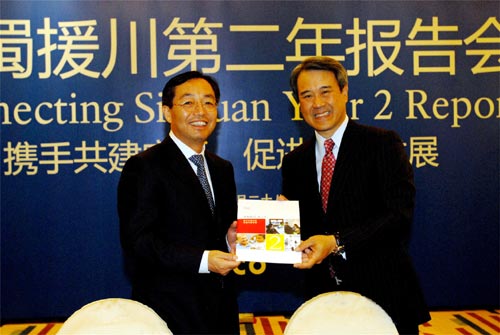Society
Cisco releases 'Connecting Sichuan' Year Two Report
By Huang Zhiling and Bing Wei Edwards (chinadaily.com.cn)
Updated: 2010-07-28 22:29
 |
Large Medium Small |
 |
|
Owen Chan (right), president and CEO of Cisco Greater China, presents 'Connecting Sichuan' year two report to Huang Xiaoxiang, vice governor of the Sichuan provincial government, on Wednesday morning. [Photo/chinadaily.com.cn] |
CHENGDU - Cisco, the worldwide leader in networking, on Wednesday delivered its 'Connecting Sichuan' year two report to the Sichuan provincial government, detailing the company's progress in collaborating with a multitude of local partners to improve the state of education and healthcare in the province after the devastating May 12th Wenchuan earthquake struck two years ago.
At a meeting held jointly by Cisco and the Sichuan provincial government on Wednesday morning, Cisco provided a look at the past year's accomplishments in the Connecting Sichuan program to assist post-quake reconstruction.
Huang Xiaoxiang, vice governor of the Sichuan provincial government, and Owen Chan, president and CEO of Cisco Greater China, attended the meeting.
The report details major progress in the implementation of a collaborative healthcare model that links the resources of top urban hospitals to patients in rural areas.
For example, a regional healthcare network now connects all 32 health institutions in Shifang, a city in northern Sichuan, achieving an unprecedented pooling of resources.
In education, more than 500 21st century classrooms have been equipped with advanced technology that allows more than 31,000 students in rural areas to learn in new, interactive ways, and a virtual education solution allows rural students to remotely attend classes taught by master teachers in urban schools.
According to the report, the first year of the Connecting Sichuan program was devoted primarily to planning, designing innovative solutions, implementing pilot projects and testing their effectiveness.
With the participation of more than 75 partners, the first year of the Connecting Sichuan program laid a solid foundation for Year Two.
Aimed at establishing a foundation for long-term sustainability, Year Two focused on five categories: finalizing infrastructure, training programs, testing for successful solution utilization, risk mitigation and sustainability.
Over the past year, a new corporate social responsibility (CSR) concept emerged known as Collaborative CSR. This holistic, multiparty, long-term approach is designed to create a sustained advantage for communities and individuals throughout the province. Collaborative CSR has been a key factor in Connecting Sichuan's successful reconstruction efforts.
"Cisco has always been committed to giving back in China, and we are pleased to be part of the Sichuan rebuild efforts," said Owen Chan.
"Along with our partners, we have put in place the 21st century healthcare and education technologies and solutions in Sichuan, a model that can be replicated around China and the world," he said.
"In its third year, we will focus on helping the communities in Sichuan to fully utilize the technologies and solutions to achieve long-term sustainability," he added.
Closely aligned with the overall Wenchuan earthquake recovery model and with China's Health 2020 reform plan, the Connecting Sichuan healthcare initiative aims to create innovative models of 21st century healthcare that can be replicated in other parts of Sichuan and China.
Cisco designed and implemented models that use technology to increase access to healthcare, improve the quality of care and establish a platform to address the shortage of resident medical personnel, one of the most pressing healthcare problems facing rural China today.
As hospitals and clinics are rebuilt, networking technologies are being installed in select communities that will help to form regional healthcare information networks under a collaborative care model.
These networks enable the sharing of physical and human resources, such as remote consultations between local doctors and distantly located specialists, greatly raising regional medical standards. They also facilitate ongoing medical education and the sharing of best practices to foster professional development and long-term sustainability.
Connecting Sichuan also supports an innovative education initiative which uses state-of-art technology to improve educational access and quality, and to bridge the gap between urban schools and schools in rural areas.
Connected classrooms have been set up to enable distance learning as part of 21st century education models that have been designed and implemented in 27 schools, including one college.
A virtual education solution also allows rural schools to gain access to highly qualified teachers while local teachers are able to observe and work with master instructors.
Cisco has prioritized the expansion of the Cisco Networking Academy in Sichuan as a key component in its commitment to help cultivate local talent. Cisco has launched 50 new Networking Academy sites in Sichuan. Networking academies equip students with the knowledge and skills necessary to meet the needs of a growing IT industry.
As the Connecting Sichuan program enters its third year, the initiative will be primarily devoted to underpinning long-term sustainable benefits to the local communities, said Owen Chan.
Focusing on a "human infrastructure" that builds on the physical and technical infrastructure established in the first two years, this will require working closely with local leaders who share a commitment with Cisco to cultivating local ICT talent and learning from global best practices, he said.